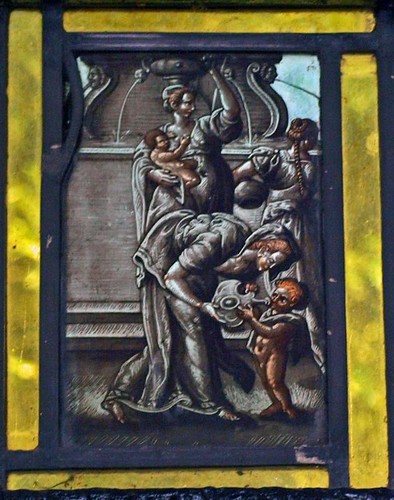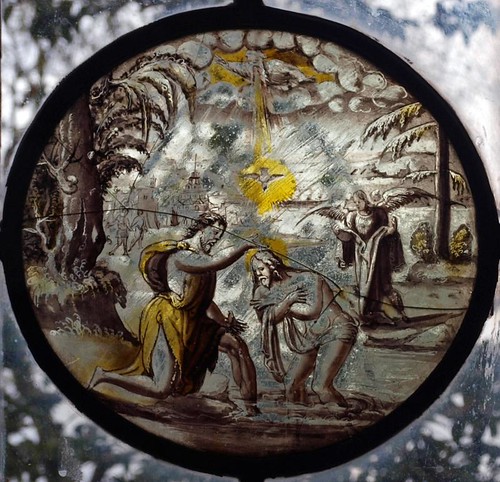Strangely under reported, all the windows, except the east chancel, are plain glass with the medallions set therein. This makes for a wonderfully light and airy interior; despite the fact that the pews have been replaced with classroom chairs I loved this church.
ST EDMUND KING AND MARTYR. Big Perp stone W tower with diagonal buttresses, battlements and higher stair turret. At the base a little fiushwork decoration. Of the same time most of the church - see the tracery of the windows. However, several were replaced in the C18 by big bare pointed openings. Perp N arcade of four bays with tall two-centred arches and piers of a section in which four deeply undercut attached shafts are connected by deep hollows so that a non-intermittent wavy section results. The chancel arch and the arch from the chancel to the N chapel are of the same type. - FONT. Octagonal, C15, with uncommonly pretty blank arches. - PULPIT. Early C17, still with its tester. - PLATE. Elizabethan Cup with two bands of ornament.
EAST MERSEA. It is said that the Danes took refuge here in Alfred’s day; and nearly a thousand years afterwards English troops were garrisoning the church during our wars with the Dutch and the French. There is still an ancient moat near the church, and close by is a lovely garden in the shadow of noble pines, a charming bit of Essex which we may see by opening a door and peeping in.
There is much to delight us on this island of trees and hedgerows, a patch of loveliness separated from the mainland by the Pyefleet Creek, which was famous for oysters in the days when Baring Gould was preaching here before he went to live in Devon. He put this village into one of his books, and ministered in the bare church that has been here 600 years. It has a 15th century font with a bowl resting on angels, fragments of glass painted in Chaucer’s day, and a beautiful pulpit carved in Stuart times, still with its canopy and the stand of the old hourglass.
Simon K -
From Colchester station, I cycled eleven miles and across the Strood causeway onto Mersea Island. I do like the Essex coast, and as I crossed the mudflats at low tide I recalled Betjeman and ...the level wastes of sucking mud, where distant barges high with hay come sailing in upon the flood... but once you are on the island it is little different from the rest of agricultural East Anglian north Essex, except for the concentration of caravanners' cars.
Open. This church is a surprise, a delight. The rugged exterior of
ragstone gives way to a beautiful, simple interior, very reminiscent
of nearby Fingringhoe, one of my favourites. Clean white walls, brick
floors, modern chairs. The church feels almost entirely untouched by
the Victorians. The clear glass of the windows is punctuated by about
20 Flemish roundels of the 16th and 17th centuries. A 17th century
pulpit with hourglass is stranded high up by the south wall after the
removal of the box pews in the 1920s.
The feeling is light, well-kept and devotional. This is a super church, and needs to be in my Essex top 20.
There is much to delight us on this island of trees and hedgerows, a patch of loveliness separated from the mainland by the Pyefleet Creek, which was famous for oysters in the days when Baring Gould was preaching here before he went to live in Devon. He put this village into one of his books, and ministered in the bare church that has been here 600 years. It has a 15th century font with a bowl resting on angels, fragments of glass painted in Chaucer’s day, and a beautiful pulpit carved in Stuart times, still with its canopy and the stand of the old hourglass.
Simon K -
From Colchester station, I cycled eleven miles and across the Strood causeway onto Mersea Island. I do like the Essex coast, and as I crossed the mudflats at low tide I recalled Betjeman and ...the level wastes of sucking mud, where distant barges high with hay come sailing in upon the flood... but once you are on the island it is little different from the rest of agricultural East Anglian north Essex, except for the concentration of caravanners' cars.
The town is West Mersea, but at the other end of the island alone in
the fields (apart from the caravans) is St Edmund.
The feeling is light, well-kept and devotional. This is a super church, and needs to be in my Essex top 20.



No comments:
Post a Comment